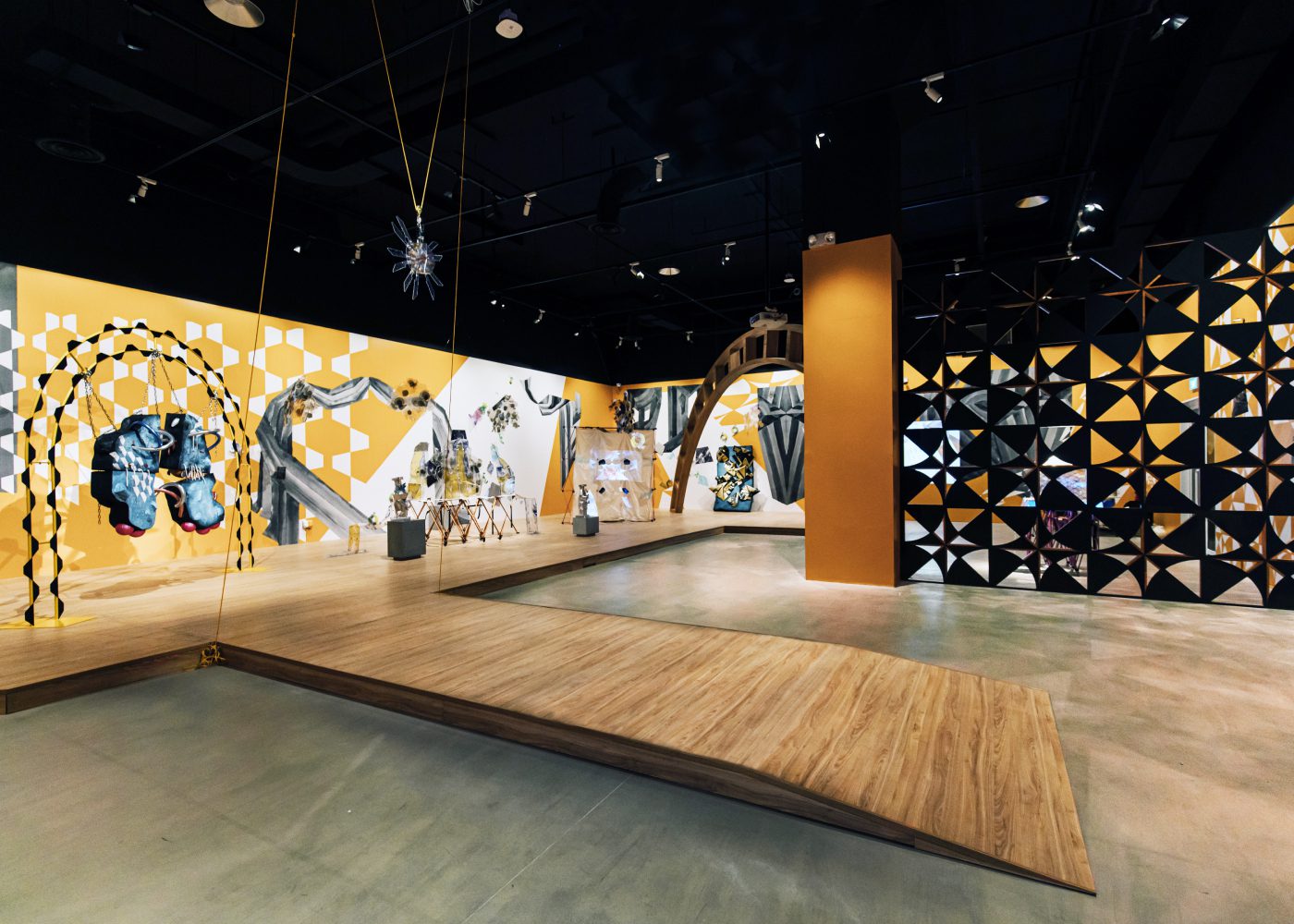Slow
Conversations
Issue: On Technological Materiality
Issue: On Technological Materiality
Joo Choon Lin is a visual artist and poet whose works explore the relationship between consciousness and the technologies of representation. Underlying her practice is a philosophical interest in the nature of reality, and the relationship between phenomena and experience. Informed by developments in technologies of representation, she experiments with a range of materials and media in an expansive body of work that is both deeply meditative as it is playful and inventive.
Filed under: animation, found objects, film, installations, performance, prints, technology, text
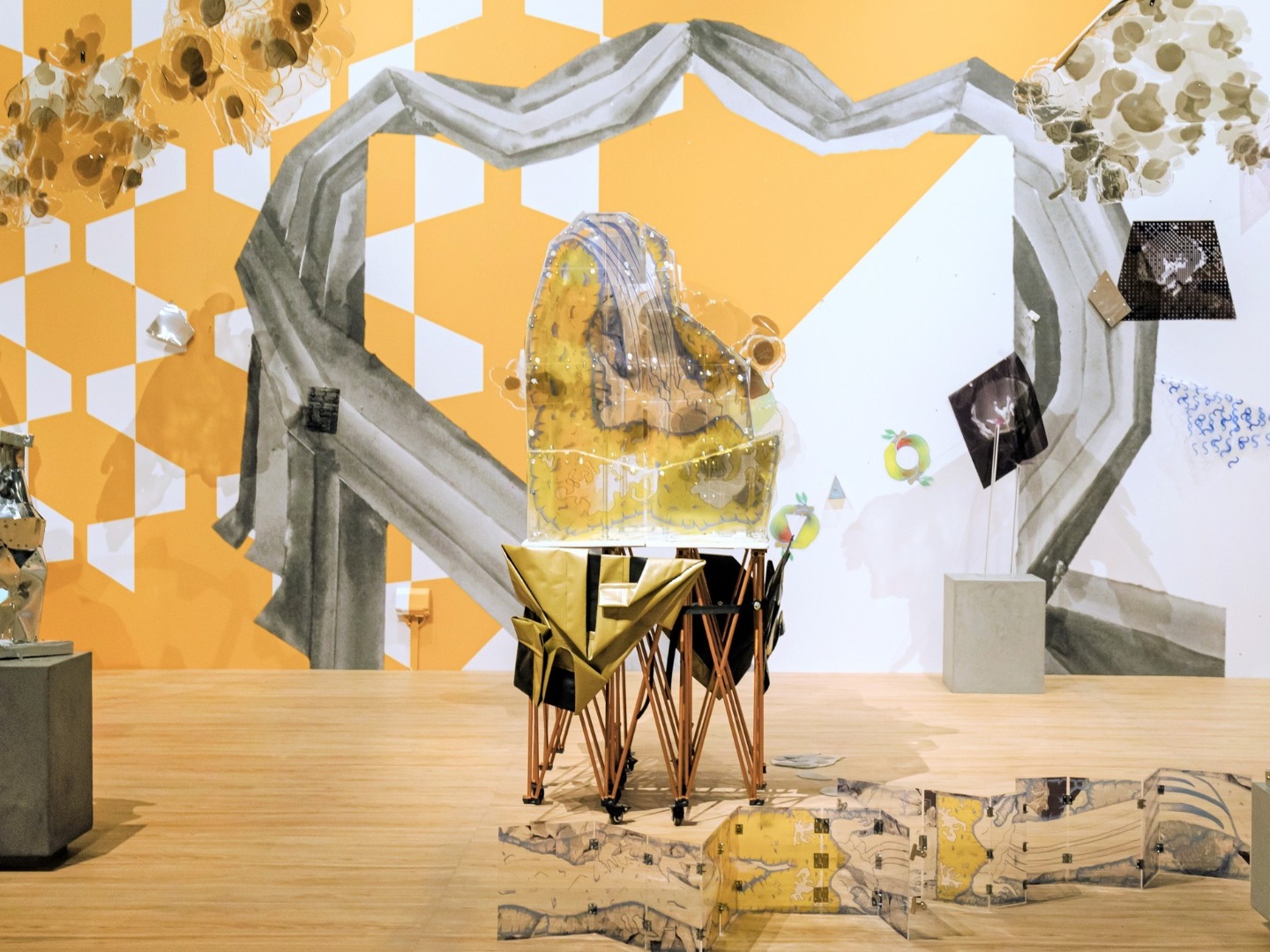

¹ Sketch of sound moving in spiral patterns akin to the spirals of a morning glory, Joo Choon Lin
Let’s begin the conversation with one of the objects you picked for this conversation: a morning glory plant that is growing outside your studio. You’ve shared that you were drawn to the spiral configuration of the morning glory, with its subtle variation in leaves, size and colour. Tell us about why you are drawn to this relationship between nature and mathematical spiral patterns, and how you have seen it reflected in your artworks.
Spiral patterns are fascinating natural phenomena which you can find in the shapes of seashells, in the Milky Way, and even in the structure of our DNA. The idea that everything is connected can be seen in the way that these spiral patterns are found in different forms throughout the universe—all forms and shapes somehow eventually succumb to this mathematical property. In my work, the use of spiral patterns can evoke a sense of movement, transformation and dynamism, as well as a connection to the natural world.
When I was working on Mission Control, I wanted to devise a way to make music without having a background as a musician. I needed to find other templates for inspiration, and I found one in the morning glory. It inspired me to play the sound in a spiral-like fashion, creating variations in tone, speed, or pitch — like the variation in leaves and colour of the morning glory — and to use the Fibonacci sequence and golden ratio as notations for musical improvisation. The plant, in twining towards the sun as it grows, is also very organic. On the other hand, the Fibonacci sequence is very objective and calculated. Both have similarities to my creative process, which is spontaneous and intuitive, and yet follows a mathematical formula. It helped me develop a more personal approach to music making.
² Mission Control, Joo Choon Lin
2020
2020
This relationship between the organic and the mathematical is also reflected in the titles of your series, where you have played with words, symbols, numbers, and mathematical or scientific equations. I’ve always been interested in your choice of titles as playfully challenging the way we interpret these formulas, and to suggest alternative, perhaps subjective ways of reading them. Could you tell us about your approach to the scientific and objective properties that equations suggest, and the role that titles play in your work?
For me, titles always play an important role. They form an audience’s first impression, and set the tone for the piece. The symbols also create curiosity in the viewer, and give them a glimpse of my intention or inspiration. I also enjoy subverting their meaning and visual wordplay. I recognise that mathematics is often seen as a very cold discipline that deals with abstract concepts, but it is also a field that can inspire wonder, creativity, and emotion. I think the title can be an integral part of the artwork, as it can provide some depth to the piece and also serve as a bridge between the artwork and the audience.
My titles are usually quite long, and my friends sometimes have difficulties talking about my work. When they can’t read out some of the words or symbols, it creates a kind of pause – “how should I read this out?” I think there are many things we cannot express through words. There are certain things that can be very difficult to talk about through language, but symbols somehow work.
I think there are many things we cannot express through words. There are certain things that can be very difficult to talk about through language, but symbols somehow work.

³ The Sri Yantra, a form of mystical diagram used in the Shri Vidya school of Hinduism.
Speaking about symbols, another object you chose for this conversation is the Sri Yantra. It is a mystical diagram used in Hinduism that consists of nine interlocking triangles, representing the cosmos and the human body. This use of visual symbolism, both in ancient traditions and modern technology, is one that carries different meanings across various cultures. What are the affinities you draw with the Sri Yantra, and how do you consider the use of geometric shapes and universal symbols in your work? What types of symbols are you drawn towards, and what do they represent or hope to evoke?
The Sri Yantra is meant as a tool for meditation. I found it interesting that whilst the drawing is static, there's actually a movement attached to it. It's composed of an outward-moving triangle and a downward-moving triangle. At the same time, there is also stillness, because you're preparing yourself to perform meditation with the Sri Yantra. Since I encountered this diagram, I started using a lot of symbols in my work, because I feel that symbols are able to convey complex ideas or concepts in a simplified way. They can evoke emotions, represent cultural values, or convey messages that are difficult to express through words. I was really interested in how symbols are used and imbued with meaning across different cultures. I also invent my own symbols, like the double S. It's a way of creating a visual language.
The Sri Yantra, like you said, represents the unity of all things and the interconnectedness of the universe. In relation to my tarp folding sculptures, I feel that the folds and the movements come from my interest in movement and stillness. The tarp sculptures use folding as a metaphor to understand the complexity of the cosmos and imagine the infinite shapes of a continually expanding universe. In this analogy, the folding represents a constant flow of connected events—spinning, rotating and then disappearing back to nothing. The sculpture is an invitation to contemplate the poles of infinity, and then follow the infinite geometry of the universe that is breathing as it oscillates between being and nothingness, manifest and unmanifest.
⁴
Beatific Perfume On-Going Series (Pink/Turquoise Tarpaulin) Folding Sculptures, Joo Choon Lin
2022
2022
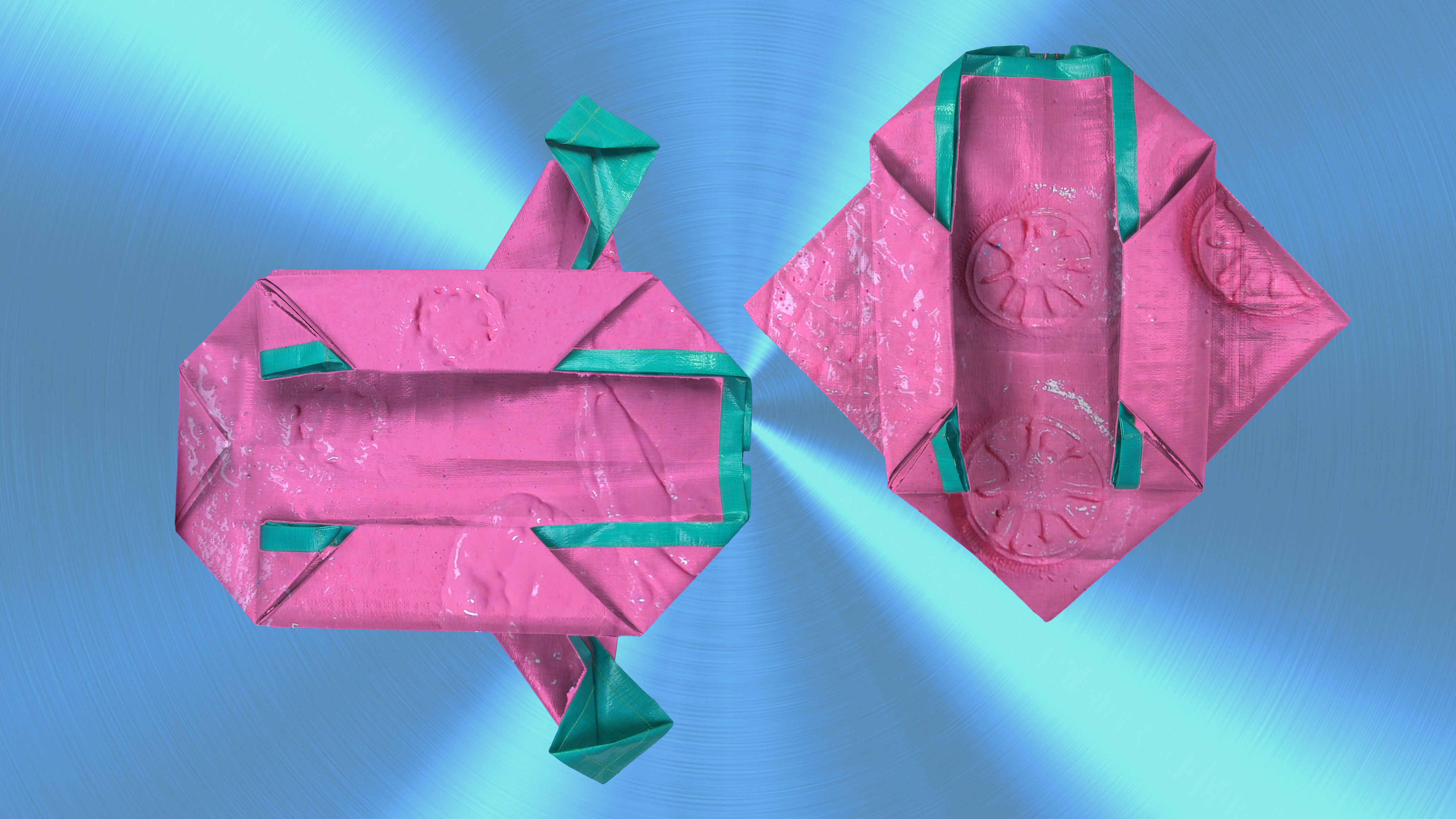
A driving concern in your work is the nature of reality, and how we perceive and experience phenomena. You’ve written that you find that “solidity is perhaps the most baffling and incomprehensible of the qualities of everyday objects”, and that it often serves to reassure ourselves of their presence. Why is it important for you that your work challenges the solidity of surfaces, and how do you approach revealing the “inherent strangeness” of objects?
When I wrote that, I was working on my Broken Tool series. I have been thinking about how we tend to freak out when we can’t hold onto something that is intangible. Something that is immaterial or that cannot be perceived by our senses is so unknown to us. We want to give it a name so that we can understand it and grasp it.
I had shared with you previously about a significant experience I had while filming in Haw Par Villa. I saw a lake covered with dense green algae, which from afar I thought was a painted green floor since Haw Par Villa is full of painterly sculptures in vibrant colours. When I came closer, a leaf dropped on the surface, creating a ripple. The concrete floor became fluid. I was struck by how this idea of solidity is something that we human beings hold onto, and sometimes take for granted. However in quantum physics, we realise that all matter is made of sub-atomic particles that are moving, pulsating and vibrating.
I recognised the limitation of my sensory perception and I wanted to explore different dimensions of reality, and to go beyond the limitations of our perception. Challenging the solidity of a surface is important in order to have a better understanding of the nature of reality, and helps us to question our assumptions about the world around us. I always feel that there's a kind of strangeness to objects. When we talk about objects which are actually pulsing interdependently, that's very strange to us and is outside of our normal perception.
Challenging the solidity of a surface is important in order to have a better understanding of the nature of reality, and helps us to question our assumptions about the world around us.
⁵ I Only Make Friends With Money (Broken Tool series), Joo Choon Lin
2012—present, Installation view at Walter Phillips Gallery, The Banff Centre
2012—present, Installation view at Walter Phillips Gallery, The Banff Centre

This connects to another point of reference you picked out for this conversation, the Advaita Vedenta. Advaita Vedenta is a Hindu spiritual tradition that is centered around non-dualism, and considers the phenomenal world of experience as illusory. Could you share with us how you encountered Advaita Vedenta, and how these ideas around the nature of reality intrigue you?
I had a series of meditative experiences through which I came to understand a sense of oneness. It’s very difficult to explain through words, but you feel that you're connected to everything. When I came out of meditation, I wanted to make sense of my experiences. I had this sense that everything was interconnected and this notion concept of one consciousness, and I wanted to find out more. In different teachings like Hinduism and Buddhism, they talk about consciousness not as within individual things and people, but the existence of one consciousness that flows through all of us. In Native American Hopi language, for example, they don't have words for past, present and future. Their sense of time is very different from ours, and they see things as being alive and consciously present in the moment. Advaita Vedenta is just one belief that goes beyond the limited self to connect with a higher level of consciousness and recognise the oneness of all existence. It’s actually quite related to quantum physics, and many neuroscientists and psychologists also refer to these concepts for their research.
I'm curious how this has fed into a specific work that you have made more recently, for example Tree’s Heartbeat.
I actually think that this concept of interconnectedness underpins most of my work, and my work is a continuous exploration of this idea. Although it was very obvious in Tree’s Heartbeat, it is less obvious in the Supernormal exhibition in 2020 where I used clay-graphite imprints on paper and the wall. In that work, there was a sculpture with screw bolts in different arrangements, which was similar to fossilized rocks cut into half. One side preserves the life form, and the other shows the negative imprint — they are two sides but part of one whole. It’s like a halved, pitted fruit where both the seed and the hollow fruit are part of the whole.
In some ways, my work talks about this notion of duality, because Advaita translates to non-dual. Binaries such as hot and cold or good and bad, are in fact non-dual. They are part of one reality.
⁶ The Hot Purity of Mathematic Love/TrustEquations={[IMPRINT] x Compression∞Expansion [+]Wiggly {Lumen]1.618[Memory -/+[TIME/SPACE] [In/out], Joo Choon Lin
2020, Installation view at Supernormal + Shophouse
2020, Installation view at Supernormal + Shophouse
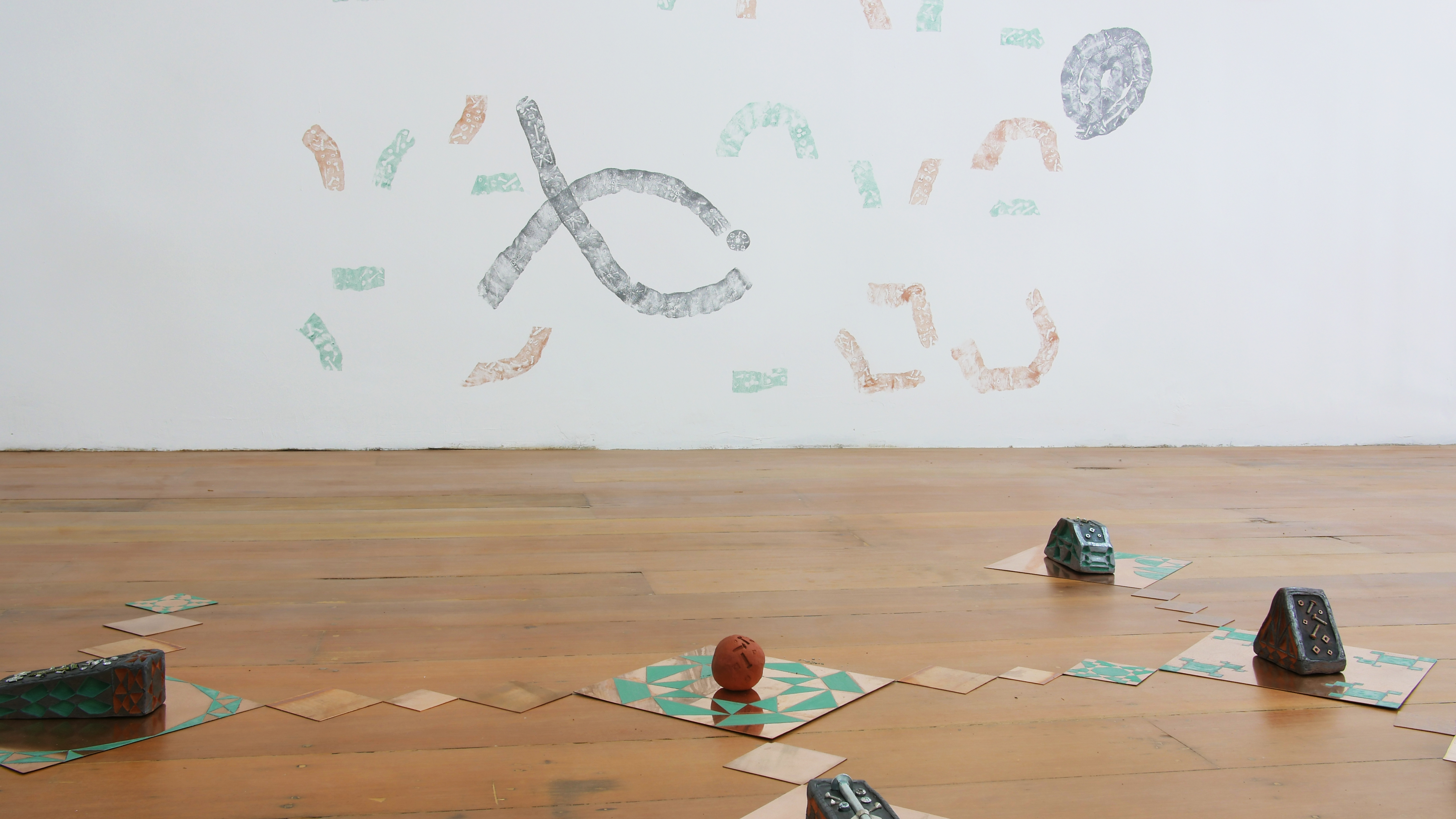
One of my favourite experiences of your work was making graphite-clay sculptures and imprints in that exhibition. Mark-making with malleable moulds and pressing hard metal bolts into them was distinctly bodily and alchemical, both in process and in its final form, and embedded in this piece are multiple dualities of time, presence and tactility. A similar interest in the human body has also surfaced in your earlier works such as the You SPLEEN Me’ Round and Intestinology series. Why are you drawn to these fleshy and visceral aspects of our physical bodies, and how do you approach the relationship between technology and the body?
When making this work, I was looking at technological advancements in materials — for example, concrete benches in parks that have been painted to look like wood, or vinyl wallpaper with glossy and high resolution prints of wood grain, and even objects made of plastic that appear to be precious stone. I was interested in how these materials impact how we perceive and experience things. I find technology and its impact on the material world intriguing. We are like astronauts in a processed world of technology, fascinated by unknown, mysterious lands as we continue to find ourselves trying to mimic nature and its form. The physicality of the material world can influence our thoughts, our emotions, social relations and human behaviour. We may even see subtle changes that could affect our biological evolution.
For example, I learnt about a distinct bone in the hand that younger generations no longer have. It is very distinct on my hand — touch it. You have a bit of it, but it’s small compared to mine. It was a biological adaptation from the past when people lived on mountains and had to use their hands to climb for food and water. These biological changes can be subtle, even something that cannot be seen inside the body. The possibility of humans evolving due to hyper adaptation was something fascinating for me at that time.
The Blinking Organism X You SPLEEN Me’ Round was a three part series that explored morphogenesis and my imagining of future biological evolution. The spleen is associated with melancholy in Shakespeare’s works, and in Chinese poetry it is related to anxiety and depression. So I used the spleen as a symbol to present all these different emotions that are affected by how things are being made now.
We are like astronauts in a processed world of technology, fascinated by unknown, mysterious lands as we continue to find ourselves trying to mimic nature and its form.
⁷ The Blinking Organism X You SPLEEN Me’ Round, Operation 2 – Mutation, Joo Choon Lin
2017, Installation view at Esplanade Concourse
2017, Installation view at Esplanade Concourse

It's interesting that these internal organs, such as the spleen and the intestine, are perhaps organs that are less visible and even alien to our everyday perception of our body, and that you chose to focus on them as key subjects and metaphors of exploration.
When my sister and I were playing as children, she accidentally swallowed a screw. As children, you’re curious and you’d want to know, for example, what paper tastes like. When she passed the screw out of her body, my mom had to look for it in her stools in order to make sure it came out of the body. I was surprised because the screw was very shiny, and I thought it could be a good metaphor for how we have all these preconceived ideas and associations about things.
We see things in a certain way, through particular filters. I wondered what one should go through in order to look at things with discernment and clarity. How does one perceive or experience in a manner that is not crowded with too many emotions, past memories and trauma? Intestinology was actually based on this story, and the process of digestion and transformation.
The subjective value of things has been a recurring interest in your practice. One way you’ve played with this is by having materials take on various forms of transmutation, such as in the wish-making money goo of I Only Make Friends with Money, as well as the copper electroplating of pennies onto graphite in The Cold Purity of Mathematic Love/Trust Equation series. How do material transformations allow you to negotiate and reassign the value that objects have in different contexts?
In I Only Make Friends With Money, I was interested in the capacity of the surface to provoke sensory experience and emotional responses. The work is an interactive piece, where audiences are invited to throw coins into a pool of synthetic goo, where the coins will slowly submerge. With the act of throwing coins, most people will immediately think of wishing wells. Maybe there's a sense of relief when we see money and objects that are burdened with meaning slowly disappear into the unknown. It's very different from watching it sink in water, because you can still see the coin even as it descends to the bottom of the well. In the goo, however, it is very slow. Sometimes, the coins will even bounce back as if it is rejecting your wishes. The material of goo takes on a very playful and strange quality, opening up a space for different interpretation and experiences.
In the first iteration, the colour of the slime was inspired by International Klein Blue, which was one of my references. The colour blue is associated with spirituality and mysticism in many cultures. Yves Klein was interested in the spiritual and emotional quality of blue, and he believed that it had a transcendent quality that could evoke a sense of the infinite and the spiritual.
In the most recent iteration, I changed the colour to respond to the gold and black in the tarp sculptures. Gold is, of course, a divine colour, but black is also associated with the divine. In Hindu belief, black doesn’t necessarily have a negative connotation. Black, as total darkness and the absence of light, essentially represents the infinite because it's boundless.
The idea of alchemy was key, especially this process of turning substances from gross material to finer or subtler elements. Though mercury is a very toxic substance, it may be found as solid beads in the context of Hinduism. Mercury in its natural form flows and moves very quickly. It is compared to the mind, where we have many thoughts or attachments to things. The solidified mercury is hence used for meditation and to enter a meditative state of mind. I find the process of turning a certain substance into something else more subtle very interesting. Sometimes I feel that my work is akin to consecrating an object. Through sound, chants and vibrations, it can exude a certain energy.
I find the process of turning a certain substance into something else more subtle very interesting. Sometimes I feel that my work is akin to consecrating an object.
⁸ The Cold Purity of Mathematic Love/Trust Equation 3 = {¢arbonHz [Golden Milk / Ω 1.618 -+ Se{E}d of ¢ФnsciФusness [TIME/MOT IOΩ] [In/out]}, Joo Choon Lin
2019, Installation view at NTU ADM Gallery
2019, Installation view at NTU ADM Gallery
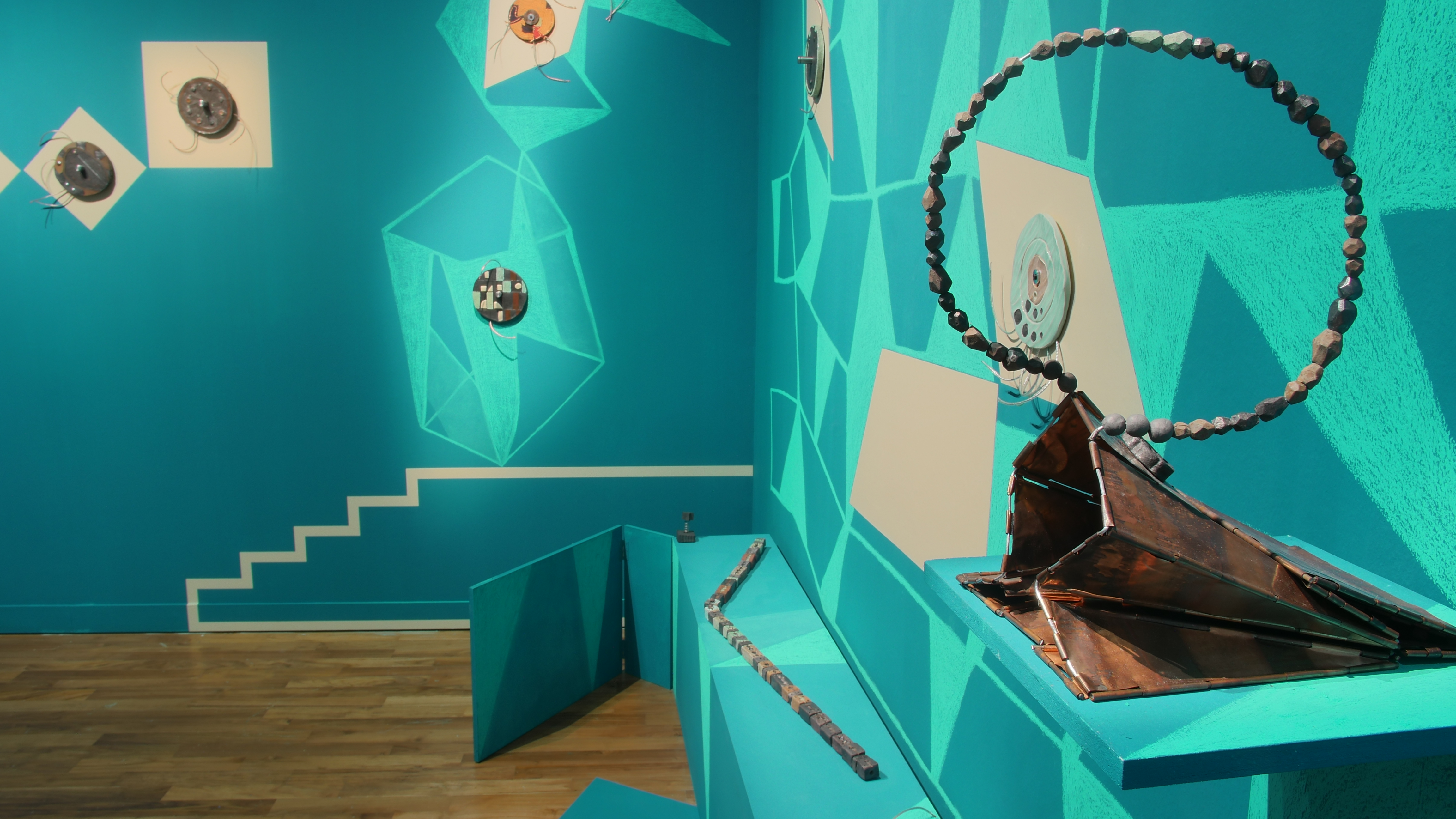
Your visual aesthetic can be described as merging low and high tech. Often your works integrate both highly refined technical components with handmade and hand-crafted elements. You also often paint, cut and construct these elements yourself, from sculptures to costumes to large-scale installations. Is this a conscious approach that you take when devising and making your works
I begin with an idea and explore all kinds of materials to find the right ones. I don’t necessarily think of technology. Let’s say drawing fully expresses the idea, then I will just keep it as a drawing. But I think this observation that my work has a mix of high tech, low tech, and handcrafted elements is quite interesting, and it is something that I don't really think about.
I actually started with printmaking, but I like to explore. Even when I was making prints, I was actually planning my prints as sculptures. I was more interested in the process: listening to the hammering and cutting of the metal plates and turning them into three-dimensional sculptures. In addition, my father was a carpenter. I remember falling asleep and waking up to the sound of hammering and drilling. I kept listening to these noises as a child and realised that they had a musical quality.
It has some kind of connection to the experience of meditation. I’m also interested in “the sound of the sound” — not the surface sound, but perhaps a different realm. It is a common experience for practitioners of meditation. When they experience the world, it is almost like vibrant colours resonate with song. I use my art as a platform to make sense of these experiences.
Your work, as mentioned, has been concerned with challenging technologies of representation and how they capture things. I was curious as to where your interest in technology began, and how experimenting with technology has provided fertile grounds for idea germination within your practice?
Technology is everywhere. Phones and laptops are extensions of ourselves and a way to amplify our capability to do things faster or more accurately. These capabilities are actually already within us, but we’re just using them to enhance or improve.
I think that technology is predictable. When this is mixed with the unpredictability of human creativity and handcraft, it can infuse a personal touch to the work. It can also provide a tactile experience for viewers, which can enhance their connection to the work. On the other hand, I think technology can provide consistency that may be very difficult to achieve with hand-crafted works. However, for me there’s no differentiation between technology and other mediums.
⁹ Für Alina, Arvo Pärt, 1976
Für Alina by Estonian composer Arvo Part combines mathematical rules with internal freedom. Arvo Part is also known for his compositional style of tintinnabula, which was influenced by his mystical experiences with chanting. It’s also notable for its use of silence that has been written into the music as a sort of acoustic space. Tell us about how you connect with this piece, and why you picked it out for our interview.
Firstly, I really like Arvo Part’s music. It’s on my playlist, and I can listen to it almost every day. The reason why I picked this piece is because of his use of silence as a compositional tool to create a profound sense of contemplation in the music. Silence in his music is not just an absence of sound, but an intentional choice in composition that is used to create a contrast with the sounds that come before and after, to give the listener time to process and absorb what they had just heard. This creates a sense of tension and release as the music alternates between moments of stillness and movement. I feel that the use of silence is also a reflection of his spiritual beliefs. He has said that his music is a way of connecting with the divine, and his music can be seen as a form of meditation or prayer to contemplate the mysteries of the universe and the meaning of life.
By inviting the audience to contemplate the unknown and the mystery of things, I see my work as a means of connecting with the divine. I also see my work as a form of meditation, and I often use repetition as part of my exploration.
By inviting the audience to contemplate the unknown and the mystery of things, I see my work as a means of connecting with the divine.
Repetition and iterative processes do feature in your works. One example you mentioned is Beatific Perfume, where you unfold and refold tarpaulin to form new sculptures. What role does iteration and repetition play in your practice?
The gesture of folding and unfolding in the tarp sculpture, along with the appearance and disappearance of coins thrown into the goo, relates to the concept of manifest and unmanifest in my work. I use the word unmanifest instead of silence, because it can also signify nothingness, emptiness and the void. The presence of the Divine is represented in the manifest (personified by Shakti, in Hinduism) and unmanifest (personified as Shiva) as two sides of the same coin of reality. In the world of appearance, one transforms into another and may take on infinite forms.
It's interesting how so much of your work is so spiritual and conceptual, but the manifestations are rooted in recognizable and everyday materials which you transform into something mystical. You came across the tarpaulin in a shop and was attracted to its colours and durability — how they have creases and the memories of folding, but they can be almost infinitely folded until they break down. You're still looking to everyday objects to talk about these ideas.
That's the only way that I can explore these ideas. I see them as two sides of the same coin. The physical dimension of manifest and the non-visible dimension of the unmanifest are actually the same. Even if I'm using physical materials, the material is also part of the unmanifest.
In your recent exhibition Dance in the Destruction Dance, you remade an older work, Glue Your Eyelids Together, that was first made for State of Motion in response to a film by Paolo Cavara. It’s a piece that is designed to deform and be destroyed over time, and you described the piece as a “death-object” which I find quite interesting — inherent in it is a sense of violence and destruction, but also a vitality and life. Could you share with us how this work came to be, and how you see these tensions at play?
For State of Motion, I was asked to respond to the film, The Wild Eye by Paolo Cavara, by making a work. The main character, who is also the filmmaker, is called Paolo. He and his crew are on a mission to record human behaviour and capture the totality of human condition in a pretty morbid way. The film begins with the whole crew, including the filmmaker, stranded in a desert, caused by an intentional car breakdown. Even as they were dying of dehydration, he was trying to capture it on camera. It’s just one example of the film’s violent and destructive elements which I borrowed in my work. For example, I set up a frame in which the balloons will slowly deflate and cause the sculpture to crumble and deform. This was based on the violence in the film. In a way, I feel that destruction and creation should be seen side by side — similar in nature, but with different energy and moving in a different direction.
Though Paolo, the filmmaker and protagonist, said he wanted to capture real life, he would move and shift certain things in the scene, even a dead body. In a similar way, I also created the work so that audiences may derive a certain viewing pleasure from them. The work self-activates, and two basketballs are attached to the bottom. When it drops, it bounces, almost like they are dancing in their death. The title, Dance in the Destruction Dance also refers to dance as a metaphor for the morphogenesis process, in which everything is constantly changing and evolving. It reminds me of cycles of transformation, and perhaps that there's no end — it merely transforms into something else.
¹⁰ Dance in the Destruction Dance, Joo Choon Lin
2023, Installation view at SAM at Tanjong Pagar Distripark
Credit: Singapore Art Museum
2023, Installation view at SAM at Tanjong Pagar Distripark
Credit: Singapore Art Museum
